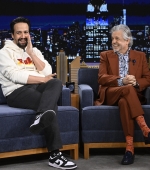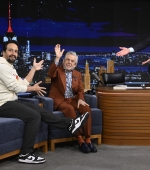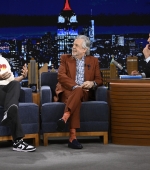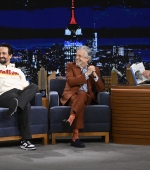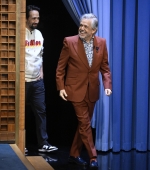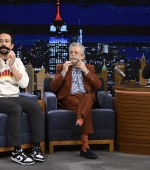We collected the inteviews, video and written, that Lin-Manuel Miranda gave so far to promote In The Heights movie.
Let’s start with Jake’s Takes.
Under the cut you can find more interviews, videos and articles: Tara Hitchcock, KTVU, Hola Jag!, ET Canada, ETalk, The Morning Show, BEONDTY, Hoy Dìa and Billbord.
BILLBOARD: In the Heights was born in the winter of 1999 in Lin-Manuel Miranda’s dorm room at Wesleyan University, inspired by what simply wasn’t there. “It was, in many ways, an attempt to write what I saw was missing, both in terms of representation and in terms of stories about [Latinos] in popular culture,” he says.
Now, Miranda’s story has made its way to movie theaters as an adaptation of the Broadway show that ran from 2008-11 — one of the few Latin musicals to become a feature film. “It meant everything to [playwright] Quiara [Alegría Hudes] to get the journey to the finish line and onto the stage and into the world and onto the screen,” adds Miranda.
It’s a journey that has taken two decades and many rides on New York’s A train, where Miranda rewrote much of his original score, while also working with arranger/producers Bill Sherman and Alex Lacamoire, both of whom worked on Hamilton. Miranda says that “about five notes from the DNA of the Wesleyan version” carried over to the movie, directed by Jon M. Chu (Crazy Rich Asians) and filmed in Manhattan’s Washington Heights neighborhood, a tiny, mostly Dominican microcosm of the Latin experience. (The movie was originally slated for a summer 2020 release but was delayed due to the coronavirus pandemic.)
In the Heights tells the story of young Usnavi, a role Miranda relinquished to Hamilton co-star Anthony Ramos, a former understudy who stepped into the part during a Washington, D.C., production in 2018 after the original actor hurt his foot. Usnavi (whose the name, common in many Caribbean port cities, riffs off the “U.S. Navy” stamp emblazoned on ships), a young bodega owner who lives with his grandmother Claudia (Olga Merediz), spends his days pining for Vanessa (Melissa Barrera), who wants to be a fashion designer. The cast includes such up-and-comers as Dominican-American singer Leslie Grace, who took on the role of Nina, while Gregory Diaz IV portrays Usnavi’s nephew, a “Dreamer” with an alcoholic father played by Marc Anthony. (Miranda says he wasn’t shy about shooting down suggestions to cast stars who “tested international,” like Jennifer Lopez or Shakira.)
Given how much time has passed since the original theater version, there were, of course, some tweaks. Sonny wasn’t originally a “Dreamer,” nor did Marc Anthony’s role exist. And Nina, who originally goes to Princeton, became a Stanford student with different hurdles. “We wanted an Afro Latina lead as Nina to go further in terms of the struggles she faced in Stanford,” says Miranda, explaining the decision to cast Dominican-American singer Leslie Grace. “It wasn’t just her feeling out of place, but the little racist micro-aggressions that can happen — and we were so incredibly very lucky to find Leslie because she can sing and she’s a wonderful artist and performer.”
That In The Heights resonates so deeply speaks to Miranda’s ability to portray the specific in universal terms. “I’m a Nuyorican with a Mexican grandfather who grew up in a Dominican neighborhood. The golden standard is to grab the things we share, not the things that make us different,” he says. “We’re all from different countries, and I’m trying to grab the things we have in common and sing their alabanza.”
Bringing the story and its young cast of developing artists to the forefront is even more powerful when considering Latinos represent only 4.5% of speaking roles in U.S. films, even though they represent 18% of the U.S. population and 23% of the moviegoing public, according to a 2019 study by the University of Southern California’s Annenberg Inclusion Initiative.
“It’s the paradox of, ‘We don’t have Latino stars that test international,’ so you don’t take chances on young talent and you don’t make stars that test international,” says Miranda. “Many of the biggest Latin stars in the world are music stars,” he adds. “Bad Bunny can reach No. 1 on [the Billboard 200] all in Spanish… and now everyone is, ‘When’s Bad Bunny doing movies?’ But again, that’s Hollywood passing the buck to the music industry to create stars for them. Busting up those cycles is really important.”
It’s why he’s proving that investing in young Latin talent can be just as fruitful, evidenced by the opening musical number that brings to life the beat of the clave, the quintessential Latin rhythm, in spectacular fashion.
“The opening clave betrays [those] who really listen to Latin music and [those] who only know show tunes,” says Miranda with a laugh. “The people who only know show tunes go, ‘What a cool homage to “America” from West Side Story.’ No, [composer] Leonard Bernstein is doing an homage to Latin music. The three and the two is the fundamental building block for many of our rhythms.”
In spite of how many boundaries In the Heights has already broken, Miranda admits that one story “can’t hold it all.”
“I also want Latinos who see In the Heights and say, ‘That wasn’t my experience. I didn’t grow up in a Latino neighborhood’ — and then begin to write that experience. Because the more stories we have, the stronger we are.”
